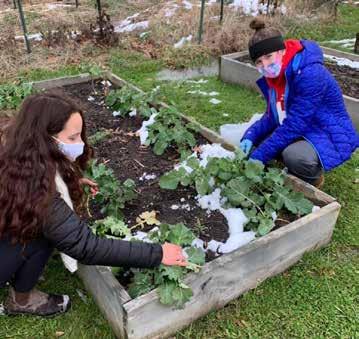Gardening for a Cause Otterbein contributes to community gardening initiative By Madeline Malynn
T
he students at Otterbein College have developed green thumbs while gardening for their community. With its initiative, Planting with a Purpose, Otterbein donates fresh produce to local food pantries. The garden has been a popular part of campus, having begun at the beginning of the decade. “The garden came about in 2010 and it has been a thriving landscape for education and the alleviation of food insecurity since that time,” says Dr. Melissa Gilbert, associate dean of Otterbein. The focus of the garden has been entirely one of service and the philanthropic efforts of those involved have not gone unnoticed. “The purpose from the very beginning has been to be a give back garden,” says Gilbert. “We wanted to make a space for the students to serve and to give back to the community.” The idea for the garden came about while discussing how to use available land on campus. This garden allows students the opportunity for study, service and aids the community in the process. “We knew one of our local partners, the food pantry, was having trouble growing produce so we saw this as the
18 May/June 2021
perfect opportunity to intersect both,” says Gilbert. An impressive array of food grows on the college campus with more than 42 different types of produce. The most abundant vegetables and fruits are zucchini, squash, strawberries, pumpkins and potatoes. When it comes to logistics, there are three separate student organizations that serve different purposes in the garden. “The three groups are called Seed, Weed and Bees. Seed focuses on mostly vegetable work, specifically planting and harvesting. Weed focuses on new strategies for growing and maintaining the garden. Bees focuses on the animals and insects of the garden,” says Gilbert. All three groups work on specific projects to further the well-being of the garden. Seed comes once a week to do the planting and focuses on food security, and Weed works with Sustainable Westerville. They work on projects like gutter gardens and build things that make gardening more sustainable and innovative. Bees have made birdhouses, bee houses and butterfly houses. These groups are important to keeping up with the challenges of the garden. “The gardening landscape is very fluid, so trying to keep up with the most innovative practices can be a challenge. We want to grow as much produce as we can and try to be as organic as possible. Pest control also serves as an obstacle,” says Gilbert. The hard work of the students is an invaluable part of the effort.
"Most of our students are not farmers or have never worked in gardening before," says Gilbert. "Seeing them plant a seed for the very first time in their lives is what is amazing." Madeline Malynn is a contributing writer. Feedback welcome at feedback@cityscenemediagroup.com. www.westervillemagazine.com








